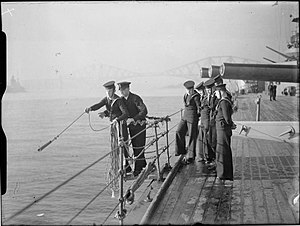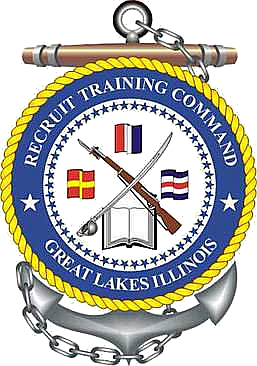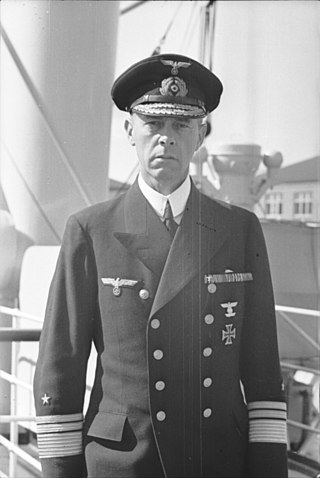This article needs additional citations for verification .(May 2011) |

A boy seaman (plural boy seamen) is a boy who serves as seaman or is trained for such service.
This article needs additional citations for verification .(May 2011) |

A boy seaman (plural boy seamen) is a boy who serves as seaman or is trained for such service.
In the British Royal Navy, where there was a need to recruit enough hands to man the vast fleet of the British Empire, extensive regulations existed concerning the selection and status of boys enlisted to keep filling the ranks.
Various specific terms were introduced for different age- and exam-related stages in a boy's potential career:
It is widely believed that the loss of 134 Boy seamen in the 1939 sinking of HMS Royal Oak caused the Royal Navy to reconsider its position on Boy seamen in combat, such was the uproar in Parliament when the sinking was announced.
Neither the Royal Navy nor the British government have ever confirmed this to be true, although shortly afterwards, Boy seamen were withdrawn from front line service and the Royal Navy thereafter only sent Boy seamen into battle in 'drastic circumstances'.
Possibly the most famous Boy seaman is Boy 1st Class Jack Cornwell, who was posthumously awarded the Victoria Cross for gallantry at the Battle of Jutland during World War I.
Prior to the First World War, the United States Navy allowed males under the age of 18 to serve on ships who were officially referred to as "boys".
In 1828, ships were allowed to have boys between 14 and 18 at the ratio of one boy for every two guns the ship carried. (i.e. a 44 gun frigate could have up to 22 boys in its crew.) Article 464 of Naval Regulations published in 1833 stated, "A recruiting officer shall enter no boy under thirteen years of age; nor any person under twenty-one years of age, without the consent of their parent or guardian".
The Circular Relating to the Enlistment of Boys in the United States Navy issued on 8 April 1875 by Secretary of the Navy George M. Robeson, provided for the enlistment, with parental consent, of boys between the ages of 15 and 18 (i.e. not past their 18th birthday) until their 21st birthday. Each boy enlisted has to be "of robust frame, intelligent, of perfectly sound and healthy constitution, free from any physical defects or malformation; and not subject to fits." The boys also had to be at least 5 feet 1 inch high and measure 30 inches around the chest. The boys would be enlisted as second-class boys and be paid $10.50 per month and one ration. Boys were not permitted to make allotments to their parents and were allowed to draw only one dollar per month for "pocket money". This practice was officially called a "minority enlistment" and remained in effect, except that the minimum age of enlistment was increased, until the 1960s.
The training of the boys was to take place on the steam frigate USS Minnesota, then stationed at the New York Navy Yard. Boys who proved their abilities onboard Minnesota could be promoted to First Class Boy. The boys would be transferred to a sea going vessel upon their 18th birthday.
In the 1880s, Captain (later Rear Admiral) Stephen B. Luce established an apprentice training program in the U.S. Navy where males as young as 15 could be enlisted, with their parents' permission, and then serve an apprenticeship on training ships before being assigned to the fleet. The first six months were on a stationary training ship where the apprentices learned fundamental skills which included basic literacy, gunnery, seamanship and shipboard maintenance. The next phase of training was assignment to a cruising training ship where the apprentice was expected to complete both a winter and a summer cruise before being sent to ship in the fleet.
Luce's theory behind the apprentice training program was to provide the Navy with young sailors who were already trained and adapted to shipboard life. This was in contrast to traditional recruiting which would take any able bodied applicant and have them learn on the job. The problem with the traditional method was that many of the new "landsmen" (i.e. inexperienced sailors) were unable to adapt to Navy life or were sometimes criminals. The apprentice program, Luce hoped, would give the Navy the opportunity to make good sailors during their formative years which, in the long run, would provide better trained and more disciplined sailors in the enlisted ranks.
The apprentice program ended with the establishment of the Recruit Training Center at Naval Station Great Lakes in 1911. In the few years prior to World War I, the Navy rapidly expanded and needed new sailors in large numbers as quickly as possible. The result was the abolition of the apprentice program and the establishment of an 8 week "boot camp" which would transform civilians into sailors in a much shorter time frame.
In 1909, Navy regulations were changed so that the minimum age for enlistment was raised to 17 with parental permission and 18 without. Recruits enlisted under age 18 served until they reached age 21 at which point, they could be discharged or, if they chose, re-enlist for four years.
A midshipman is an officer of the lowest rank in the Royal Navy, United States Navy, and many Commonwealth navies. Commonwealth countries which use the rank include Canada, Australia, Bangladesh, Namibia, New Zealand, South Africa, India, Pakistan, Singapore, Sri Lanka, and Kenya.

Impressment, colloquially "the press" or the "press gang", is the forced conscription of men into a military or naval force via intimidation and physical coercion, conducted by an organized group. European navies of several nations used forced recruitment by various means. The large size of the British Royal Navy in the Age of Sail meant impressment was most commonly associated with Great Britain and Ireland. It was used by the Royal Navy in wartime, beginning in 1664 and during the 18th and early 19th centuries as a means of crewing warships, although legal sanction for the practice can be traced back to the time of Edward I of England. The Royal Navy impressed many merchant sailors, as well as some sailors from other, mostly European, nations. People liable to impressment were "eligible men of seafaring habits between the ages of 18 and 55 years". Non-seamen were sometimes impressed as well, though rarely. In addition to the Royal Navy's use of impressment, the British Army also experimented with impressment from 1778 to 1780.
Seaman apprentice is the second lowest enlisted rate in the U.S. Navy, U.S. Coast Guard, and the U.S. Naval Sea Cadet Corps just above seaman recruit and below seaman; this rank was formerly known as seaman second class.

Seaman is a military rank used in many navies around the world. It is considered a junior enlisted rank and, depending on the navy, it may be a single rank on its own or a name shared by several similarly junior ranks.

Stephen Bleecker Luce was a U.S. Navy admiral. He was the founder and first president of the Naval War College, between 1884 and 1886.From 1909 to 1910 he was vice president,from 1910 to 1911 president of the Aztec Club of 1847.

The surface warfare insignia is a military badge of the United States Navy which is issued to U.S. Navy personnel who are trained and qualified to perform duties aboard United States surface warships. There are presently four classes of the surface warfare pin, being that of line, staff, special operations, and enlisted. The line and enlisted surface warfare badges may be earned by United States Coast Guard personnel assigned to Navy commands. The various badge types are as follows:

A hospital corpsman is an enlisted medical specialist of the United States Navy, who may also serve in a U.S. Marine Corps unit. The corresponding rating within the United States Coast Guard is health services technician (HS).
William Brown was a Black woman who joined the Royal Navy in the early nineteenth century. It is undisputed that she was a sailor of HMS Queen Charlotte, but historians have reached varying conclusions about her service record.

The United States Navy's Officer Candidate School provides initial training for officers of the line and select operational staff corps communities in the United States Navy. Along with United States Naval Academy (USNA) and Naval Reserve Officer Training Corps (NROTC), OCS is one of three principal sources of newly commissioned naval officers.
Landsman or landman was a military rank given to naval recruits.
Able seaman is a military rank used in naval forces.
Ordinary seaman is a military rank used in naval forces.

The United States Navy occupational rating of boatswain's mate is a designation given by the Bureau of Naval Personnel (BUPERS) to enlisted members who were rated or "striking" for the rating as a deck seaman. The colloquial form of address for a boatswain's mate is "Boats".

The Recruit Training Command, Great Lakes, is a command unit within the United States Navy primarily responsible for conducting the initial orientation and indoctrination of incoming recruits, also known as boot camp and recruit training, or RTC. It is part of Naval Service Training Command. It is a tenant command of Naval Station Great Lakes in the city of North Chicago, Illinois, in Lake County, north of Chicago.

The Kriegsmarine was the navy of Nazi Germany prior to and during World War II. Kriegsmarine uniform design followed that of the preexisting Reichsmarine, itself based on that of the First World War Kaiserliche Marine. Kriegsmarine styles of uniform and insignia had many features in common with those of other European navies, all derived from the British Royal Navy of the 19th century, such as officers' frock coats, sleeve braid, and the "sailor suit" uniform for enlisted personnel and petty officers.

Royal Navy ranks, rates, and uniforms of the 18th and 19th centuries were the original effort of the Royal Navy to create standardized rank and insignia system for use both at shore and at sea.

The History of the United States Navy ratings spans more than 200 years of U.S. history from the United Colonies of the 1775 era to the current age of the 21st century United States Navy. Navy ratings in America were first created in 1775, during the American Revolutionary War, for use by the Continental Navy. After securing independence, the fledgling United States was without an operational Navy for nearly a decade. In 1797, the first three frigates of the United States were formally launched, bringing about new regulations concerning enlisted seaman ratings

The Master-at-Arms (MA) rating is responsible for law enforcement and force protection in the United States Navy—equivalent to the United States Army Military Police, the United States Marine Corps Military Police, the United States Air Force Security Forces, and the United States Coast Guard's Maritime Law Enforcement Specialist. It is one of the oldest ratings in the United States Navy, having been recognized since the inception of the U.S. Navy.
The Imperial Japanese Navy was created in 1868, initially the officers and sailors who manned the new navy reflected the composition of the Meiji government's bureaucracy. Samurai who originated from the victorious coalition of south-western domains dominated the navy's small officer corps. These domains which had led the restoration, particularly Satsuma, also dominated the numbers of recruits sent to the new Naval Academy which had opened in October 1869. The leadership of the new navy later took steps to reform recruitment into the officer corps, and to establish the creation of a system of recruitment based on merit rather than on class or region. In 1871, the government announced that applicants would be accepted from the public at large and that entry would be based upon competitive examinations. Eventually, in the words of Arthur Marder, the Imperial Japanese Navy turned out officers of "unquestioned professional competence, fanatical courage, and extraordinary elan". The IJN molded among the ranks a standard of discipline, self-sacrifice, and devotion to duty that became the envy of all navies in the world. Japan's later victories at sea, one commentator has observed, "came as much from the training and morale of the average Japanese seaman as from the effectiveness of the navy's ships or the caliber of its guns".